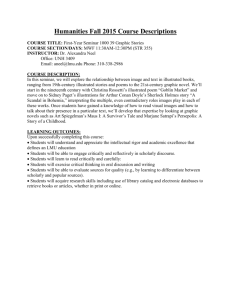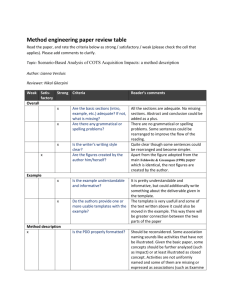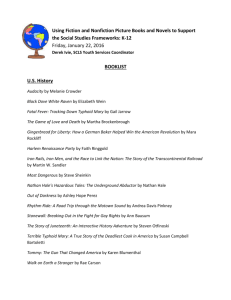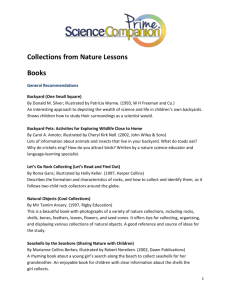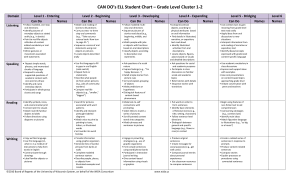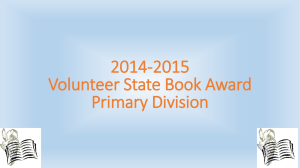WiDA Supports for Grades 1 and 2 Revised
advertisement
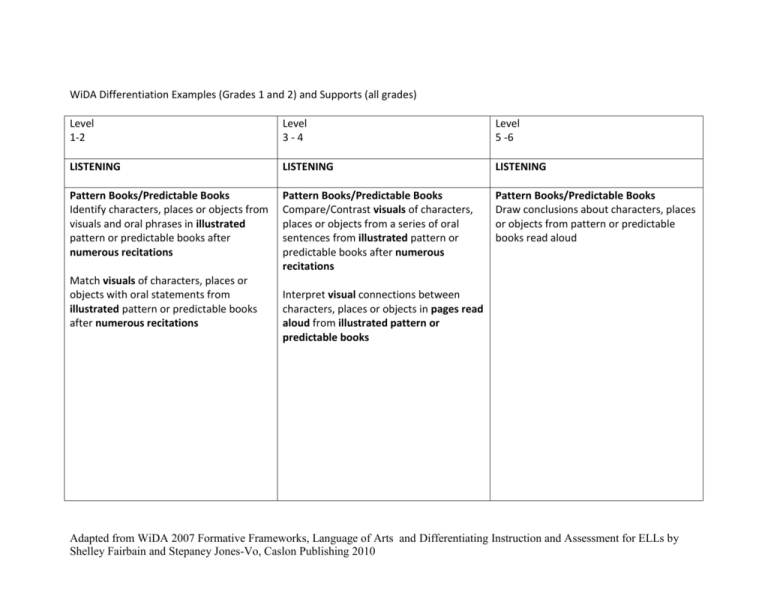
WiDA Differentiation Examples (Grades 1 and 2) and Supports (all grades) Level 1-2 Level 3-4 Level 5 -6 LISTENING LISTENING LISTENING Pattern Books/Predictable Books Identify characters, places or objects from visuals and oral phrases in illustrated pattern or predictable books after numerous recitations Pattern Books/Predictable Books Compare/Contrast visuals of characters, places or objects from a series of oral sentences from illustrated pattern or predictable books after numerous recitations Pattern Books/Predictable Books Draw conclusions about characters, places or objects from pattern or predictable books read aloud Match visuals of characters, places or objects with oral statements from illustrated pattern or predictable books after numerous recitations Interpret visual connections between characters, places or objects in pages read aloud from illustrated pattern or predictable books Adapted from WiDA 2007 Formative Frameworks, Language of Arts and Differentiating Instruction and Assessment for ELLs by Shelley Fairbain and Stepaney Jones-Vo, Caslon Publishing 2010 Supports Background building with pictures/illustrations/photos Real world connections Supports Background building with pictures/illustrations/photos Real world connections Wait time Use simplified, correct language Teacher read aloud in small groups Read alouds with repetition and or/paraphrasing Read alouds with modeling/gestures by teacher Multiple read alouds of same book Think alouds to model process and language TPR- total physical response One step directions Provide graphic organizers to complete with an oral reading Use of illustrations/photos to show understanding Wait time Use increasingly complex language, paraphrasing as needed Teacher read alouds in small groups Think alouds to model process and language TPR Acting parts/role play to show understanding Provide graphic organizers to complete with an oral reading Whole group with scaffolding Small groups Partners Supports Background building Real world connections Model and prompt increasingly difficult academic and grammatically complex varied language about both concrete and abstract topics. Allow minimal errors Provide graphic organizers to complete with an oral reading Whole group Small groups Partners Partners Small group with teacher/adult support Adapted from WiDA 2007 Formative Frameworks, Language of Arts and Differentiating Instruction and Assessment for ELLs by Shelley Fairbain and Stepaney Jones-Vo, Caslon Publishing 2010 Level 1-2 Level 3-4 Level 5 -6 READING READING READING Phonics Demonstrate awareness of unique sounds by pointing or through gestures Phonics Cross-check pictures with phonics clues with a partner Phonics Predict words or phrases based on context cues in grade-level text Match voice to print by pointing to icons, letters or illustrated words Cross-check pictures with phonics clues with a partner Story Sequencing Sequence a series of pictures to tell stories Story Sequencing Select titles that correspond to a sequence of pictures Match a series of pictures that tell stories with sequence words (e.g., "first," "then," "last") Sequence a series of sentences to related pictures Pair illustrated features or photographs of places or objects with icons in non-fiction books in small groups Connect illustrated features or photographs of places or objects with descriptive words or phrases in nonfiction books in small groups Connect illustrated features or photographs of places or objects with descriptive words or phrases in non-fiction books in small groups Categorize illustrated features of places or objects using graphic organizers and sentences in non-fiction books in small groups Story Sequencing Sequence short paragraphs to tell stories Summarize features of places or objects from multiple compound sentences in non-fiction books Adapted from WiDA 2007 Formative Frameworks, Language of Arts and Differentiating Instruction and Assessment for ELLs by Shelley Fairbain and Stepaney Jones-Vo, Caslon Publishing 2010 Supports Extensive visual support Build background and make connections to prior learning High quality, age appropriate, lower reading level, content books Supports Build background and make connections to prior learning High quality, age appropriate, lowerreading-level books aligned with content curriculum Pointing gesturing Use props/acting to increase comprehension Songs/chants Big books Pictures/illustrations/posters/charts Word walls/phrases Word/phrase cards with photo or illustration for definition Match illustrations/pictures with words Graphic organizers to show comprehension LEA- language experience approach stories Graphic organizers Big books Sentence/rhyme completion Pictures/illustrations Phrase/title cards Word/phrase cards with photo or illustration for definition Match illustrations to phrases/sentences LEA- language experience approach stories Guided reading Leveled readers- word/short sentence level with visual support/labels Audio books Supports Background building Combination of grade-level texts (with scaffolding) and high quality, ageappropriate, lower level reading books aligned with content that provide visual support Graphic organizers Audio books Guided reading Guided reading Leveled readers-multiple sentence per pages with visual support/labels/simple headers and other nf features Audio books Small groups Sight word books Theme vocabulary books Adapted from WiDA 2007 Formative Frameworks, Language of Arts and Differentiating Instruction and Assessment for ELLs by Shelley Fairbain and Stepaney Jones-Vo, Caslon Publishing 2010 Teacher-student Small groups Adapted from WiDA 2007 Formative Frameworks, Language of Arts and Differentiating Instruction and Assessment for ELLs by Shelley Fairbain and Stepaney Jones-Vo, Caslon Publishing 2010 Level 1-2 Level 3-4 Level 5 -6 SPEAKING SPEAKING SPEAKING Fiction Name people (e.g., "boy," "man") or objects depicted on illustrated covers of fictional stories with a partner in L1 or L2 Fiction Predict ideas in storylines based on titles and illustrated covers of fictional stories and share with a partner Fiction Connect storylines to personal experiences based on titles and illustrated covers of fictional stories Describe people or objects in titles and Make up the beginning of storylines based illustrated covers of fictional stories with a on titles and illustrated covers of fictional partner in L1 or L2 stories and share with a partner Create original stories from series of pictures, wordless picture books, or personal experiences Story Telling (Retell) Repeat new language related to story pictures or wordless picture books modeled by teachers Story Telling (Retell) Create original stories from series of pictures, wordless picture books, or personal experiences Story Telling (Retell) State actions of characters or describe events depicted in story pictures or wordless picture books in small groups or pairs Describe people or places depicted in story pictures or wordless picture books in small groups or pairs Tell stories from pictures or wordless picture books in small groups or pairs Supports Supports Supports Adapted from WiDA 2007 Formative Frameworks, Language of Arts and Differentiating Instruction and Assessment for ELLs by Shelley Fairbain and Stepaney Jones-Vo, Caslon Publishing 2010 Yes/no questions Pointing at correct answer Wait time L1 Teacher modeling/repeating Provide sentence examples Simple Wh- questions Sentence/rhyme completion Word banks Illustrations Concentrate on meaning rather than correctness T-P-S with guidance and modeling Small groups with teacher/adult support Partners Wh- questions Modeling/repeating of sentences Sentence starters and frames Word/phrase banks Illustrations/pictures Concentrate on meaning rather than correctness Provide opportunities for extended oral interaction through activities such as reporting and presentations rwingrWhole group with scaffolding T-P-S with guidance Partners Small groups Discourse level sentence frames and models for high quality academic discourse (“When I ____________ I always have fun because _____________.”) Insist on increasingly correct and precise language Provide opportunities for extended oral discourse, increasingly inclusive of abstract thought Whole group Small group Partners Adapted from WiDA 2007 Formative Frameworks, Language of Arts and Differentiating Instruction and Assessment for ELLs by Shelley Fairbain and Stepaney Jones-Vo, Caslon Publishing 2010 Level 1-2 Level 3-4 Level 5 -6 WRITING WRITING WRITING Rhyming Words Reproduce symbols, letters, or pictures of rhyming pairs from illustrated charts or displays with a partner Rhyming Words Produce and organize rhyming words from pictures on charts, displays, or graphic organizers with a partner Rhyming Words Create original stories or poems using rhyming words in sentences from charts or displays Pair rhyming words from illustrated charts Use rhyming words in phrases or short or displays with a partner sentences from illustrated charts or displays with a partner Folktales Copy words related to settings or characters in illustrated folktales from word walls or big books Folktales Compare/Contrast two characters, settings or events in illustrated folktales using graphic organizers with a partner Describe settings or characters in illustrated folktales from phrase walls or big books Relate sequence of events to characters and settings in illustrated folktales using graphic organizers with a partner Supports Supports Folktales Connect events, characters or morals in illustrated folktales to self Supports Adapted from WiDA 2007 Formative Frameworks, Language of Arts and Differentiating Instruction and Assessment for ELLs by Shelley Fairbain and Stepaney Jones-Vo, Caslon Publishing 2010 Draw and label Draw then write Cut, paste, label Alphabet charts Illustrations Charts Displays Word Walls Big Books LEA –language experience approach Graphic organizers Keep simpe word journals- word and picture label level Provide sentence examples and models Concentrate on meaning rather than correctness of expression Partners Draw, label and write word/short sentence level Short sentence models Sentence starters/frames Word walls/phrase walls Pictures Charts Displays Graphic organizers LEA Provide opportunities for journaling, report writing, and preparing presentations Provide visually supported sentence- level frames and models for high quality academic discourse (“As a result of the interaction between _______ and __________ ,…”) Concentrate on student meaning to a greater extent than correctness of expression Charts Displays Word Walls/phrase walls Word journals Provide visually supported sentence- level frames and models for high quality academic discourse (“In accordance with our hypothesis, ….”) Insist on increasingly correct and precise language Partners Adapted from WiDA 2007 Formative Frameworks, Language of Arts and Differentiating Instruction and Assessment for ELLs by Shelley Fairbain and Stepaney Jones-Vo, Caslon Publishing 2010 Adapted from WiDA 2007 Formative Frameworks, Language of Arts and Differentiating Instruction and Assessment for ELLs by Shelley Fairbain and Stepaney Jones-Vo, Caslon Publishing 2010
